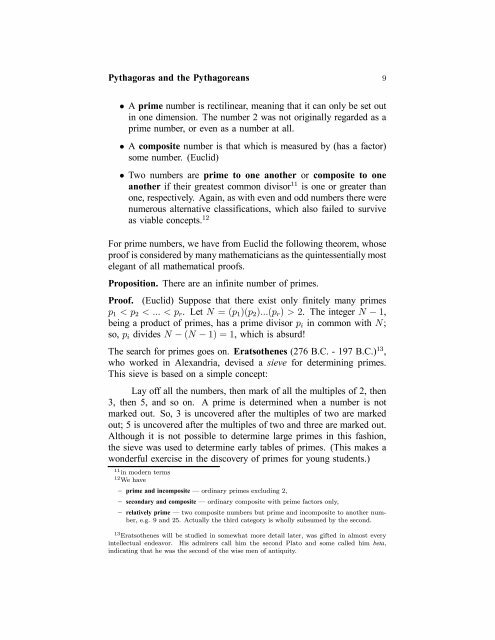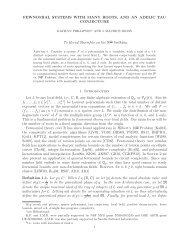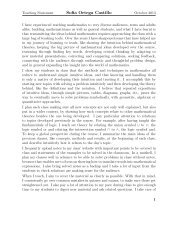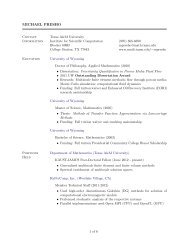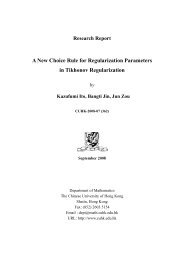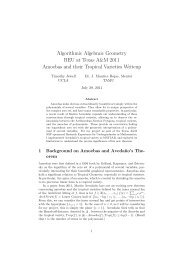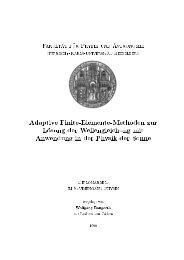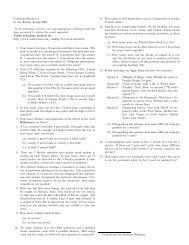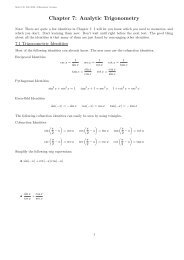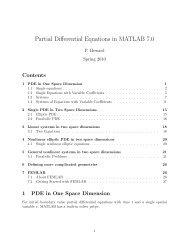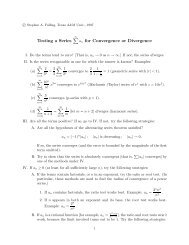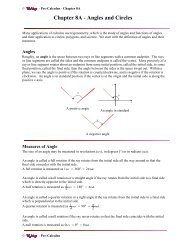Pythagoras and the Pythagoreans - Department of Mathematics
Pythagoras and the Pythagoreans - Department of Mathematics
Pythagoras and the Pythagoreans - Department of Mathematics
Create successful ePaper yourself
Turn your PDF publications into a flip-book with our unique Google optimized e-Paper software.
<strong>Pythagoras</strong> <strong>and</strong> <strong>the</strong> <strong>Pythagoreans</strong> 9<br />
• A prime number is rectilinear, meaning that it can only be set out<br />
in one dimension. The number 2 was not originally regarded as a<br />
prime number, or even as a number at all.<br />
• A composite number is that which is measured by (has a factor)<br />
some number. (Euclid)<br />
• Two numbers are prime to one ano<strong>the</strong>r or composite to one<br />
ano<strong>the</strong>r if <strong>the</strong>ir greatest common divisor 11 is one or greater than<br />
one, respectively. Again, as with even <strong>and</strong> odd numbers <strong>the</strong>re were<br />
numerous alternative classifications, which also failed to survive<br />
as viable concepts. 12<br />
For prime numbers, we have from Euclid <strong>the</strong> following <strong>the</strong>orem, whose<br />
pro<strong>of</strong> is considered by many ma<strong>the</strong>maticians as <strong>the</strong> quintessentially most<br />
elegant <strong>of</strong> all ma<strong>the</strong>matical pro<strong>of</strong>s.<br />
Proposition. There are an infinite number <strong>of</strong> primes.<br />
Pro<strong>of</strong>. (Euclid) Suppose that <strong>the</strong>re exist only finitely many primes<br />
p1 2. The integer N − 1,<br />
being a product <strong>of</strong> primes, has a prime divisor pi in common with N;<br />
so, pi divides N − (N − 1) = 1, whichisabsurd!<br />
The search for primes goes on. Eratso<strong>the</strong>nes (276 B.C. - 197 B.C.) 13 ,<br />
who worked in Alex<strong>and</strong>ria, devised a sieve for determining primes.<br />
This sieve is based on a simple concept:<br />
Lay <strong>of</strong>f all <strong>the</strong> numbers, <strong>the</strong>n mark <strong>of</strong> all <strong>the</strong> multiples <strong>of</strong> 2, <strong>the</strong>n<br />
3, <strong>the</strong>n 5, <strong>and</strong> so on. A prime is determined when a number is not<br />
marked out. So, 3 is uncovered after <strong>the</strong> multiples <strong>of</strong> two are marked<br />
out; 5 is uncovered after <strong>the</strong> multiples <strong>of</strong> two <strong>and</strong> three are marked out.<br />
Although it is not possible to determine large primes in this fashion,<br />
<strong>the</strong> sieve was used to determine early tables <strong>of</strong> primes. (This makes a<br />
wonderful exercise in <strong>the</strong> discovery <strong>of</strong> primes for young students.)<br />
11in modern terms<br />
12We have<br />
— prime <strong>and</strong> incomposite – ordinary primes excluding 2,<br />
— secondary <strong>and</strong> composite – ordinary composite with prime factors only,<br />
— relatively prime – two composite numbers but prime <strong>and</strong> incomposite to ano<strong>the</strong>r number,<br />
e.g. 9 <strong>and</strong> 25. Actually <strong>the</strong> third category is wholly subsumed by <strong>the</strong> second.<br />
13 Eratso<strong>the</strong>nes will be studied in somewhat more detail later, was gifted in almost every<br />
intellectual endeavor. His admirers call him <strong>the</strong> second Plato <strong>and</strong> some called him beta,<br />
indicating that he was <strong>the</strong> second <strong>of</strong> <strong>the</strong> wise men <strong>of</strong> antiquity.


